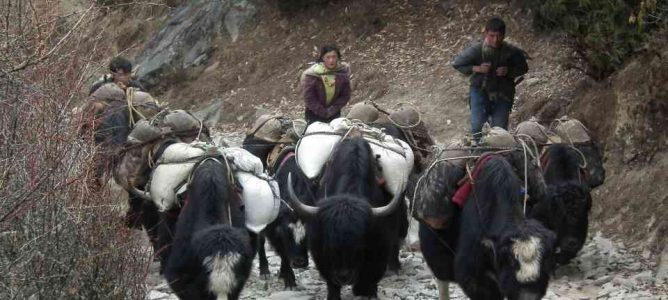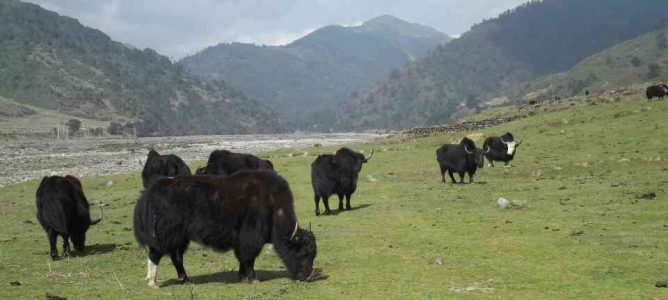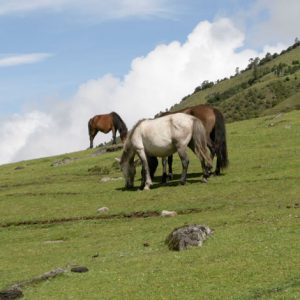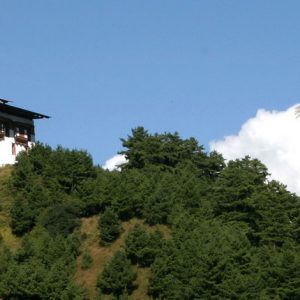Day 1: ARRIVE AT GUWAHATI INTERNATIONAL AIRPORT – SAMDRUP JONGKHAR (L/D)
Upon arrival at Guwahati International Airport in India, you will be met by an English speaking representative. Then it is about a three hour drive to Samdrup Jongkhar in Bhutan. After lunch, explore the border town of Samdrup Jongkhar town as well as go across the border to the Indian town of Mela Bazar.
Dinner and overnight at your hotel in Samdrup Jongkhar.
Day 2: SAMDRUP JONGKHAR – TRASHIGANG (B/L/D)
After breakfast, we will drive to Trashigang through a beautiful forest. If weather permits, we will stop for a while at Tshelingkhor to view the valleys of the southern foothills. Visit Trashigang Dzong which is on the high promontory that overlooks the confluence of the Drangme Chu and Gamri Chu rivers. It was built in 1667 by Chogyal Mingyur Tempa, Bhutan’s third Desi (Governor).
Dinner and overnight at your hotel in Trashigang.
Day 3: TRASHIGANG – CHALING – DAMNONGCHU (B/L/D)
The trek to Merak will start from Chaling reached by following an unsealed road from Rangjung. The 15km feeder road from Rangjung to Chaling takes about 1 hour by car. The first overnight camp will be at Damnongchu which is about 3316m above sea level.
Dinner and overnight camping at Damnongchu.
Day 4: DAMNONGCHU – MERAK (5hrs, camp altitude 3499m) (B/L/D)
The trail from Damnongchu to Merak goes along the river bank with gradual ups and downs. The final stretch is a very gentle incline after which you enter Merak village. The campsite, located before the village, has spectacular views of the nearby mountains and the village. There is also a guesthouse and home stays where tourists can stay if they choose not to camp.
Dinner and overnight camping at Merak.
Day 5: MERAK – MIKSA TENG (B/L/D)
The trek from Merak to Miksa Teng is long and of medium difficulty. It will pass through the beautiful Nagchungla pass (approx 4100m/13451ft). Right after the Nagchungla pass, the trek descends mostly along the river and then there is a small climb before reaching the village of Miksa Teng. The campsite is located in a clearing surrounded by rhododendron trees. It is beautiful when the flowers are in full bloom.
Dinner and overnight camping at Miksa Teng.
Day 6: MIKSA TENG – SAKTENG (B/L/D)
The trek to Sakteng from Miksa Teng is easy as you make your way through beautiful woods with a short, but relatively easy climb before reaching Sakteng. If you are lucky you may be able to spot a red panda among the trees. The Sakteng campsite is located on the outskirts of the village. Sakteng also offers trekkers the option of spending the night in a guesthouse/home stay instead of camping.
Dinner and overnight camping at Sakteng.
Day 7: SAKTENG DAY HALT (B/L/D)
Time to explore this remote Himalayan village.
Dinner will be arranged with a typical traditional dance of Sakteng.
Overnight camping at Sakteng.
Day 8: SAKTENG – JYONKHAR TENG (6 ½hrs, camp altitude 1859m) (B/L/D)
Sakteng to Jyonkhar Teng is an easy trek compared to the previous trekking days. It is mostly downhill and walking on a plain path to Jyonkhar Teng. Some trekkers can also make it to Phongmey or Radhi but a halt in Jyonkhar is recommended. Jyonkhar village is located a few minutes’ walk from the campsite. It also has a community school. The campsite is located near a river.
Dinner and overnight camping at Jyonkhar.
Day 9: JYONKHAR TENG – PHONGMEY (5hrs, 1981m) (B/L/D)
The final day of your trek will take about 5 hours with ups and down until you reach the road head at Phongmey/Radhi. Drive through to Trashigang.
Dinner and overnight at your hotel in Trashigang.
Day 10: TRASHIGANG – MONGAR (B/L/D)
After breakfast, drive to Mongar. In the evening, visit Mongar Dzong. This dzong was rebuilt in 1953 and is quite small. There are around 50 to 60 monks in the dzong, many of them young boys eight to ten years old. In the dzong there is an image of the Buddha of long life as well as one of the Guru Rimpoche (who brought Buddhism to Bhutan).
Dinner and overnight at your hotel in Mongar.
Day 11: MONGAR – BUMTHANG (B/L/D)
After breakfast, drive to Bumthang via Ura.
Dinner and overnight at your hotel in Bumthang.
Day 12: BUMTHANG – SIGHTSEEING (B/L/D)
After breakfast, visit Me-bar Tsho (Burning Lake) and Tamshing Lhakhang.
After lunch, visit Jambay Lhakhang, Kurje Lhakhang, and Kenchosum Lhakhang and also visit the Jakar Dzong, built by Chogyal Minjur Tempa, the 3rd Desi in 1646 AD.
Dinner and overnight at your hotel in Bumthang.
Day 13: BUMTHANG – THIMPHU (B/L/D)
After breakfast, drive to Thimphu.
Dinner and overnight at your hotel in Thimphu.
Day 14: THIMPHU – PARO (B/L/D)
After breakfast, we will drive to Dodeyna to climb through a beautiful forest track to the Tango Monastery which overlooks a forested valley and other Buddhist retreats high in the mountains. Then we visit the National Memorial Chorten built in honor of Bhutan’s late King Jigme Dorji Wangchuck before visiting the Giant Sakyamuni Buddha statue atop Kuensel Phodrang, the mini zoo at Motithang to see the Takin, Bhutan’s national animal.
Then visit Tashichho Dzong, seat of the national government and the Central Monastic Body which includes the summer residence of the Je Khenpo (Chief Abbot of Bhutan). If you wish we can then visit the Handicrafts Emporium followed by shopping for souvenirs and other items in the shops of Thimphu.
Later in the evening, we will drive through to Paro.
Dinner and overnight at your hotel in Paro.
Day 15: TAKTSANG MONASTERY OR TIGER’S NEST (B/L/D)
After breakfast, we will drive you to the trail head to commence a climb through beautiful pine forest. We will stop for light refreshments at the Taktsang cafeteria before walking on to the famous, Taktsang monastery or Tiger’s Nest. The primary Lhakhang or main temple was built around Guru Rimpoche’s meditation cave in 1684 by the Penlop of Paro, Gyalse Tenzin Rabgay. This incredible monastery clings to the edge of a sheer rock cliff that plunges 900 m into the valley below. Legend has it that Guru Padmasambhava, the tantric mystic who brought Buddhism to Bhutan in 747 AD, flew here on the back of a flying tiger, Dorji Drolo from Kurtoe Singye Dzong in the east.
After lunch, we will visit Drugyal Dzong (a ruined fortress), 16 km away from Paro. Although it is now in ruins, this dzong has great historical importance for the people of Bhutan. It was a place where the Bhutanese finally defeated the Tibetan invasion. On a clear day one can view sacred Mt. Jhomolhari (mountain of Goddess). We will also visit Ta Dzong (built in 1656 and renovated in 1968), an ancient watchtower, which now houses the National Museum. Below the museum is the Rinpung Dzong (literally meaning “Heap of Jewels”), the centre of civil and religious authority in this valley, built in 1646 by Zhabdrung Ngawang Namgyal.
Dinner and overnight at your hotel in Paro.
Day 16: PARO – PARO INTERNATIONAL AIRPORT (B)
In the morning drive to Paro International Airport where your guide will accompany you to bid you farewell.

















Reviews
There are no reviews yet.